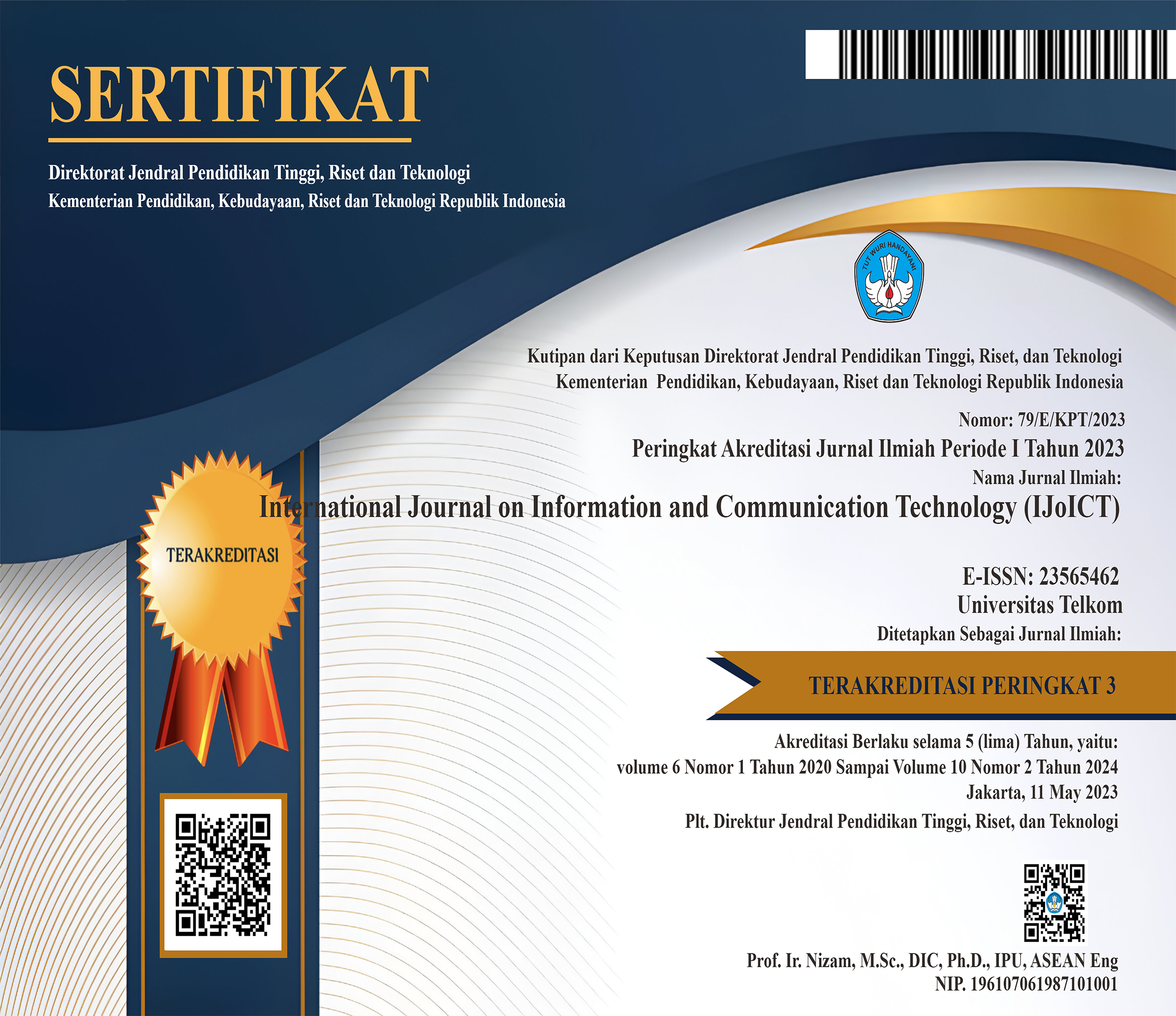Implementation of the Learner Centered Design method and the personality approach (Case Study: Redesigning The Interface mobile LMS Tel-U)
Penerapan metode Learner Centered Design dan pendekatan kepribadian (Studi Kasus: Desain ulang antarmuka mobile LMS Tel-U)
 Abstract views: 359
,
Abstract views: 359
,
 pdf downloads: 198
pdf downloads: 198
Abstract
The Mobile LMS Tel-U is an e-learning platform developed by Telkom University to support the learning process. However, it still requires more demand from Telkom University students. Usability evaluation was conducted on twelve students using the System Usability Scale (SUS), resulting in a score of 46.5. Interviews and observations revealed interface problems on the dashboard, material, grades, and quizzes. This study aims to redesign the mobile LMS Tel-U interface using the Learner-Centered Design method and incorporating a personality approach by categorizing students into introverts and extroverts. Designing based on personality groups acknowledges the differences in interface design preferences and the relationship between personality and e-learning interface design. This approach yields two different interface designs, one for introverted students and one for extroverted students. The LCD method determines student needs in supporting the learning process. The redesigned interface's usability was evaluated using SUS to assess its appropriateness for students' learning needs. The study shows an average increase in usability scores of 80.4. The introverted student group achieved a usability score of 81, while the extroverted student group obtained a score of 80. Thus, the LCD method and personality approach effectively enhance the usability of distance learning applications (e-learning).
Downloads
References
[2] I. Y. Alyoussef, “Acceptance of e-learning in higher education: The role of task-technology fit with the information systems success model,†Heliyon, vol. 9, no. 3, Mar. 2023, doi: 10.1016/j.heliyon.2023.e13751.
[3] K. B. Lee and R. Salman, “The Design and Development of Mobile Collaborative Learning Application Using Android,†2012. [Online]. Available: www.jitae.org
[4] A. Bangor, P. Kortum, and J. Miller, “Determining What Individual SUS Scores Mean: Adding an Adjective Rating Scale,†J. Usability Studies, vol. 4, no. 3, pp. 114–123, May 2009.
[5] D. Dhar and P. Yammiyavar, “Design approach for E-learning systems: Should it be user centered or learner centered,†in Proceedings - 2012 IEEE 4th International Conference on Technology for Education, T4E 2012, 2012, pp. 239–240. doi: 10.1109/T4E.2012.57.
[6] P. Y. Pratiwi and I. G. Sudirtha, “SISTEMASI: Jurnal Sistem Informasi Identification of Learning Experience in Online Learning with User Persona Techniques Based on Learner-Centered Design Concepts.†[Online]. Available: http://sistemasi.ftik.unisi.ac.id
[7] T. Alves, J. Natálio, J. Henriques-Calado, and S. Gama, “Incorporating personality in user interface design: A review,†Personality and Individual Differences, vol. 155. Elsevier Ltd, Mar. 01, 2020. doi: 10.1016/j.paid.2019.109709.
[8] J. Kim, A. Lee, and H. Ryu, “Personality and its effects on learning performance: Design guidelines for an adaptive e-learning system based on a user model,†Int J Ind Ergon, vol. 43, no. 5, pp. 450–461, 2013, doi: 10.1016/j.ergon.2013.03.001.
[9] K. Subaramaniam, J. L. Ern-Rong, and S. Palaniappan, “Interface designs with personality types: An effective E-learning experience,†Evergreen, vol. 8, no. 3, pp. 618–627, Sep. 2021, doi: 10.5109/4491654.
[10] P. Debiec, “Effective Learner-Centered Approach for Teaching an Introductory Digital Systems Course,†IEEE Transactions on Education, vol. 61, no. 1, pp. 38–45, Feb. 2018, doi: 10.1109/TE.2017.2729498.
[11] U. Ependi, T. B. Kurniawan, and F. Panjaitan, “SYSTEM USABILITY SCALE VS HEURISTIC EVALUATION: A REVIEW,†Jurnal SIMETRIS, vol. 10, no. 1, 2019.
[12] A. Battou, O. Baz, and D. Mammass, “An Interactive Adaptive Learning System Based on Agile Learner-Centered Design,†EAI Endorsed Transactions on Smart Cities, vol. 2, no. 7, p. 154106, Feb. 2018, doi: 10.4108/eai.12-2-2018.154106.
[13] B. Klimova, “Impact of mobile learning on students’ achievement results,†Educ Sci (Basel), vol. 9, no. 2, Jun. 2019, doi: 10.3390/educsci9020090.
[14] J. Brooke, “SUS: a retrospective,†J Usability Stud, vol. 8, pp. 29–40, Jan. 2013.
[15] P. Insap Santosa and dan Wing Wahyu Winarno, Evaluasi Usability pada Sistem Informasi Pasar Kerja… EVALUASI USABILITY PADA SISTEM INFORMASI PASAR KERJA MENGGUNAKAN SYSTEM USABLITY SCALE.
[16] A. Wibowo Soejono, A. Setyanto, and A. Fatah Sofyan, “Evaluasi Usability Website UNRIYO Menggunakan System Usability Scale (Studi Kasus: Website UNRIYO)â€, [Online]. Available: www.respati.ac.id
[17] J. Choi, J. H. Lee, and B. Kim, “How does learner-centered education affect teacher self-efficacy?The case of project-based learning in Korea,†Teach Teach Educ, vol. 85, pp. 45–57, Oct. 2019, doi: 10.1016/j.tate.2019.05.005.
[18] ELM Learning, “What is Learner Centered Design ?,†Aug. 02, 2022. https://elmlearning.com/blog/learner-centered-design/#:~:text=Learner%2Dcentered%20design%20focuses%20on,the%20materials%20around%20their%20experience. (accessed Oct. 29, 2022).
[19] L. Fanani, M. Tri Ananta, and K. C. Brata, “Penerapan User-Centered Design dalam Pengembangan Aplikasi Pencarian Gedung Berbasis Android,†CYBERNETICS, vol. 2, no. 02, pp. 225–233, 2018.
[20] M. Pröbster, J. Hermann, and N. Marsden, “Personas and Persons - An Empirical Study on Stereotyping of Personas,†in Proceedings of Mensch Und Computer 2019, in MuC’19. New York, NY, USA: Association for Computing Machinery, 2019, pp. 137–145. doi: 10.1145/3340764.3340771.
[21] F. R. Dam and T. Y. Siang, “Personas – A Simple Introduction,†Jan. 2022. https://www.interaction-design.org/literature/article/personas-why-and-how-you-should-use-them (accessed Oct. 26, 2022).
[22] B. R. Momintan, E. Darwiyanto, and J. H. Husen, “Pemodelan User Interface Aplikasi Pengenalan Rambu Lalu Lintas dengan Augmented Reality berdasarkan User Experience untuk Anak Usia Dini.â€
[23] 53rd Hawaii International Conference on System Sciences (HICCS), online, January 5-8, 2021. University of Hawai’i at Manoa, 2021.
[24] R. Hartson and P. Pyla, “Mental models and conceptual design,†The UX Book; Elsevier: Cambridge, UK, pp. 327–340, 2019.
[25] S. Morson, Learn design for iOS development. Apress, 2014.

This work is licensed under a Creative Commons Attribution 4.0 International License.
Manuscript submitted to IJoICT has to be an original work of the author(s), contains no element of plagiarism, and has never been published or is not being considered for publication in other journals. Author(s) shall agree to assign all copyright of published article to IJoICT. Requests related to future re-use and re-publication of major or substantial parts of the article must be consulted with the editors of IJoICT.









.png)

.jpg)




